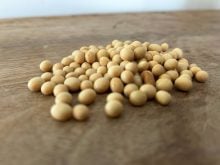PARIS, Nov 3 (Reuters) – Dry weather has delayed soft wheat sowing in western Europe but the area is expected to be generally stable on year in the absence of major weather problem, analysts said.
In top producer France, which recorded dry weather for the fourth month in a row in October, winter wheat and barley sowings were running behind last year as of early last week, farm office FranceAgriMer said.
But sowings have progressed well since and showers forecast in the largest grain region in the coming days and early next week should help relieve crops, Benoit Fayaud, crop analyst at Strategie Grains consultancy, said.
Read Also

U.S. corn and soybean yields revised down by USDA
Soybean and corn yields in the United States were revised downward from earlier estimates in updated supply/demand tables from the United States Department of Agriculture released Nov. 14.
“Rainfall was below average but for sowings you mainly need surface water,” he said.
Little rain is forecast in western Europe in the coming two weeks, with levels up to Nov. 11 below average, the U.S. National Center for Environmental Prediction said.
However, temperatures are expected to be rather low, which should reduce plants’ water needs.
“We are not in an optimal situation but we don’t see it impacting the (European soft wheat) area,” Fayaud said.
Strategie Grains last month estimated the EU soft wheat area for next year’s harvest to be stable on 2016-17’s 24.3 million hectares.
French wheat sowings last year totalled 5.4 million hectares, French farm ministry data showed.
In the EU’s second largest wheat producer Germany, wheat plantings have been successfully completed apart from fields to be sown after the sugar beet crop.
“Sowings were generally undertaken without serious problems despite dry weather in some regions,” one German analyst said. “Warm temperatures in recent weeks have enabled positive winter wheat development.”
“Based on seed sales I would expect a sown area of around 3.2 million hectares for the 2017 harvest, little changed on the year and within the five-year average.”
In the fourth largest producer Poland, sowings, still ongoing, were made difficult by a dry September and very wet October, said Wojtek Sabaranski of analysts Sparks Polska.
“We believe that winter wheat acreage for the 2017 harvest will be slightly smaller than the 1.9 million hectares planted last autumn for this year’s harvest due to unfavourable weather during the planting window,” Sabaranski said.
“Farmers also decided to plant more rapeseed for next year’s harvest at the expense of wheat.”
Britain’s winter wheat plantings are on course to match last year’s, said Jack Watts, lead analyst at the Agriculture and Horticulture Development Board.
Dry weather in south and east England has delayed some plantings, but this may be an advantage to farmers seeking to control weeds, he said.
This means farmers can attack blackgrass, one of the most difficult to control and widespread weeds in arable crops in Britain, before the wheat crop is planted.
“Farmers have been able to take a more relaxed attitude because of the weather,” he said. People may well hang on as late as they can in order to get the best conditions for the crop.”














